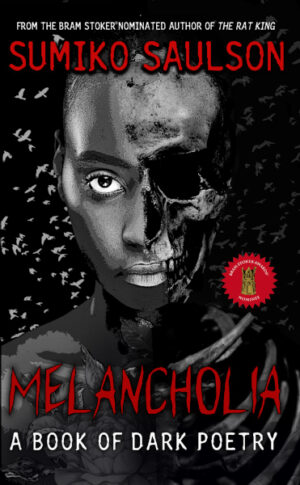Halloween Haunts: In Adolescent Clouds of Gloom
By Sumiko Saulson
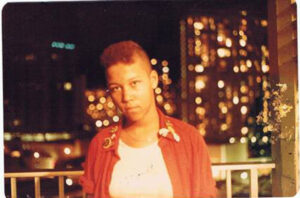
16-year-old Sumiko Saulson standing on the lanai of their apartment at Atkinson Plaza in Honolulu, Hawaii, in 1984. Photo taken by their father, Robert Saulson.
I landed at the Ambassador Hotel, in the historical Transgender District (where the Compton Cafeteria Riots took place in August 1966). The Ambassador was in the Tenderloin, San Francisco’s red light district, a rough-and-tumble 50-square-block ghetto rising up from the front doorsteps of City Hall, filled with single room occupancy (SRO) hotels like my new home, where the City’s poorest could rent a room in a building with shared bathrooms, and if you were lucky, a shared kitchen. You could stay forr 28 days in a row before being unceremoniously dumped out into the street for 3 days. That way you never established permanent residency.
Those three days were spent day-sleeping in the enormous Art Agnos-era homeless encampment in the Grand Hall across the street from the Mayor’s Office, a long, rectangular reflecting pool at its center, or spending $3 to doze off in the middle of a horror movie marathon at The Strand. Then I discovered Central City Hospitality House, a resource center for homeless and marginally housed people. The community arts program at CCHH was like college for me: the place I learned to paint, silk-screen t-shirts, and make subversive surrealist political postcards. I attended a writer’s workshop and got help to get into permanent housing at the Aarti Hotel, a cooperative space run by TNDC (Tenderloin Neighborhood Development Center).
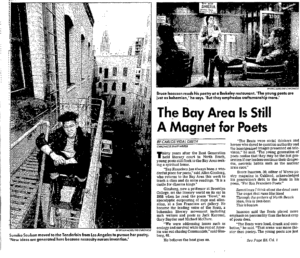
20-year-old Sumiko Saulson sits on the fire escape of their apartment in a photo for an article entitled “The Bay Area Is Still A Magnet for Poets” by Carlos Vidal Greth, in the May 16, 1988 issue of the San Francisco Chronicle
“The Tenderloin was an unlikely place to launch a literary career. Yet in the last two years, [Saulson] has attended writing workshops at Hospitality House, a homeless shelter and cultural center, and has produced two self-published collections of poetry that [they have] sold through bookstores on consignment. [They] also [have] read [their] work at the Tenderloin Self-Help Center and other social service and “outreach” organizations.” – Carlos Vidal Greth, “The Bay Area Is Still A Magnet for Poets” May 16, 1988 San Francisco Chronicle
Was there ever any doubt I was destined to become a horror poet? From the time I was an eighteen-year-old goth kid two years before the above article, listening to Lydia Lunch and William Burroughs’ “Better an Old Demon than a New God” spoken word on vinyl, it felt preordained. Excited, I announced to my parents my goal of attending UC Berkeley and making my mark on the Bay Area poetry scene. But first, I’d have to make it out of Hawaii.
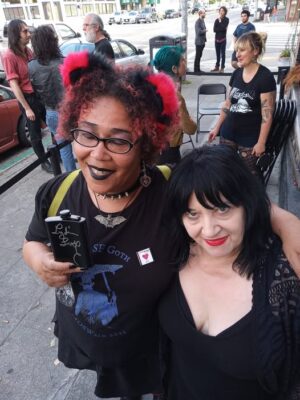
A fully grown Sumiko Saulson with Lydia Lunch—their favorite poet during high school—and a signed whisky flask outside the Ivy Room in Albany, California (near Berkeley).
Long before I became the twice Bram Stoker Award ® nominated author of The Rat King (2022) and Melancholia (2024), I was a kid in a punk band called Poetic Justice in Hawaii, writing songs about The Evil Dead. Having put out a music fanzine called Sects-Kit-10 since I was sixteen back in 1984, I had firm ideas about how to pursue my poetry dreams. I put together my first poetry chapbook, The Coffee Files (1986), and ran out to the local punk record and clothes stores with it like any good zinemaker on the scene would. Once, as a teen, I recall my mother going through my bedroom, collecting bits of artwork and poetry off the floor, and saving them in manila envelopes. The Coffee Files was a zine chapbook made in the shape of a manila envelope containing miscellaneous bits and bobs of paper covered in poetry.
“A gremlin where I used to be
Sat loathsome in my room
Cramming composition books full of poetry
In adolescent clouds of gloom”
– Sumiko Saulson, “Syndrome of the Impostor”, 2024, Melancholia
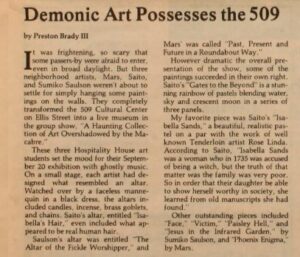
“It was frightening, so scary that some passers-by were afraid to enter, even in broad daylight. But three neighborhood artists, Mars, Saito, and Sumiko Saulson weren’t about to settle for simply hanging some paintings on the walls. They completely transformed the 509 Cultural Center on Ellis Street into a live museum in the group show, “A Haunting Collection of Art Overshadowed by the Macabre.” – Preston Brady III, “Demonic Art Possesses the 509” October 1987, The Tenderloin Times
I never made it to UC Berkeley, but shortly after I turned 19, I made it out of Hawaii and into the Bay Area. I was finally my own adult artist, poet, and songwriter, navigating poverty and the arts and poetry world of late-1980s San Francisco in a haze of adolescent pretension.
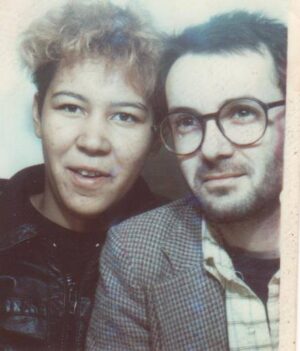
Sumiko Saulson and their good friend Adrian Paun back in 1987
“On a small stage, each artist had designed what resembled an altar. Watched over by a faceless mannequin in a black dress, the altars included candles, incense, brass goblets, and chains. Saito’s altar, entitled “Isabella’s Hair,” even included what appeared to be real human hair.
Saulson’s altar was entitled “The Altar of the Fickle Worshipper,” and Mars’ was called “Past, Present and Future in a Roundabout Way.” “A Haunting Collection of Art Overshadowed by the Macabre.” – Preston Brady III, “Demonic Art Possesses the 509” October 1987, The Tenderloin Times
I wouldn’t make it to the Berkeley coffeehouse scene until my mid-40s, but I found my home in the San Francisco art and literature scene as a nineteen and twenty-year-old. San Francisco’s Tenderloin Times paid me $25 for a series of three poems published in various issues between late 1987 and early 1988.
“As if any part of me could be separated—
Like a chemistry project.
Dissected like a frog”
– Sumiko Saulson, from “Half & Half,” March 1988 Issue, Tenderloin Times
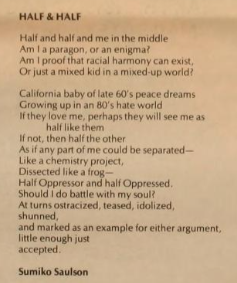
Following our hauntingly successful art show, I put together a second poetry chapbook entitled Untitled (1988). I got it on the shelves of local book stores such as McDonald’s A Poorly Lit, Dirty Place for Books in the Tenderloin (the name mocked A Clean, Well-Lit Place for Books in Opera Plaza) and started hanging out at poetry open mics at coffeeshops in the Tenderloin and the Haight Ashbury. A favorite spot was the combination laundromat and coffee house called Brainwash Cafe in the South of Market district. That year, I was featured as an up-and-coming poet on the neo-beat scene in the San Francisco Chronicle proudly defending my stomping grounds.
“I don’t see how those places are inferior to a Berkeley coffeehouse or a highbrow bookstore,” said Saulson, who wears steel-rim glasses, a painted leather jacket, and braids dyed the color of a polluted sunset. “The Tenderloin excites me,” [they] said. “New ideas are generated here because necessity nurses invention. It’s a bad place only if you let yourself get into trouble. You can sleep on the street and not get beaten up.” Saulson, who sings in a band called Poetic Justice.” – Carlos Vidal Greth, “The Bay Area Is Still A Magnet for Poets”, May 16, 1988 San Francisco Chronicle
Poetic Justice, formed by myself and lead guitarist Ron Ackerman, had followed me to San Francisco, and we were recording on old 4-tracks for an album that never came out. Later, Poetic Justice would go on without me, and my mother and I would form a punk-goth fusion band called Stagefright that played at Whisky-A-Go-Go twice. But my mother and I had a constant battle over original song material, as she wanted us to be predominantly a cover band.
In my very early twenties, I traded in a job as a graphic artist and a lot of creative aspirations for full-time work in the budding San Francisco tech industry. Although I still engaged in creative projects, they became very much a sideline until my early-to-mid 40s, when both of my parents were diagnosed with different cancers and I became an in-home care worker, taking my mother, who had multiple myeloma, to cancer treatments twice a week. I’d bring my computer with me to Mom’s chemo, and write there. Themes of death and loss are present in my horror poetry and can be found throughout the pages of my first Bram Stoker Award ® nominated book of poetry, The Rat King: A Book of Dark Poetry, a good example if this being my third-place Dwarf Star Award-winning poem “Surviving.” from the book:
Surviving others has a certain weight to it
A palpable heaviness
As though your clothing, tear-dampened
Is bearing down on you with its cloying sway
Pulling you into the floor
When you walk forward, and that grief
Compounded by grief,
Drags at your feet,
Ghosts grabbing your ankles
While you push on through
By contrast, my second book full book of poetry, the Bram Stoker Award ® nominated Melancholia: A Book of Dark Poetry is filled with callbacks to an earlier era: poems like “Mouthsounds,” and “Syndrome of the Impostor” that directly refer to early influences like William Burroughs and Edgar Allan Poe, “Coachella Ghost” that give homage to lyrics like Kurt Cobain and 2Pac Shakur who influenced me, and “Not Only Jericho Had Walls,” which refers to groundbreakers like Linda Addison. It also contains Half and Half, first published in 1988 in the Tenderloin Times, bringing me full circle from the start of my life as a poet.
Thirty-seven years later, I often wonder if I have changed very much from the twenty-year-old Carlos Vidal Greth described in the San Francisco Chronicle as one who “writes the lyrics of a rebellious child forced to grow up fast.” Twisting strands of traditional horror goblins, such as vampires and ghosts, together with subjects like Black Lives Matter in poetry anthems like “Civil Rights Act of 1968” or “The Child on the Lawn”… am I really that much more sophisticated than the pissed off punk rock kid who lyrically posited “god doesn’t care about my hair, or the kind of clothes I wear, or if I’m straight or if I’m gay?”
On a very real level, I am still that same person, only older, and wise enough to say that I don’t know if age automatically translates into wisdom or greater craftsmanship. Adolescent clouds of gloom give way to midlife grieving, and life remains complicated. Sometimes all we can do is to survive it… creating along the way.
—-
Biography: Sumiko Saulson is a two-time Bram Stoker Finalist in the Poetry Collection for Melancholia: A Book of Dark Poetry (Bludgeoned Girls Press) and The Rat King: A Book of Dark Poetry ( Dooky Zines), two-time Elgin Nominee (2022, 2024), 3rd Place Dwarf Stars Award Winner, Winner of the Ladies of Horror Readers Choice Award for the collection Within Me Without Me (Dooky Zines), and the Afrosurrealist Writers Award for “Balm of Brackish Water”. Their horror romance Somnalia: The Metamorphoses of Flynn Keahi (sequel to Happiness and Other Diseases) is available on Mocha Memoirs Press. Find Sumiko @sumikoska or www.SumikoSaulson.com
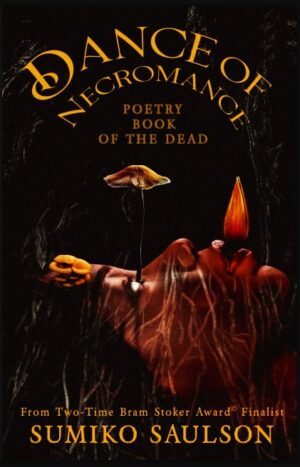
Cover of Dance of Necromance: Poetry Book of the Dead by Sumiko Saulson – coming out April 2026 on Mocha Memoirs Press. Artwork by Ruth Anne Evans, editor L. Marie Wood
Macrame
Sample Poem from Dance of Necromance: Poetry Book of the Dead
Thank you for loving me
For being a part of my life journey
And deciding I’m worthy of your energy
Strands of connectivity
Pulsing waves tendrils finer than baby hair
Knowing you’re always around
In the places our kind can be found
Sendingly we weave these tales
These webs of love and memories
All of the tension erased
Every time that we interface
Knowing that this is true
I always look forward to you
We dance our dance finite
In warmth and kindly light
Though mortal we may be
Charlotte knew how to write
And the words on her web
Could save someone’s life
The life of a fat little pig
Just like me
Put me into your verse
And I will put you into mine
Though my lines may be clumsy
And unrefined
Remember me when I’m gone
In April 2026, my third full book of poetry. Dance of Necromance: Poetry Book of the Dead, will be out on Bram Stoker Specialty Press Award-winner ® Mocha Memoirs Press. The cover is by Ruth Anne Evans, and it will be edited by Bram Stoker Award ® winner L Marie Wood. Later this year, you can expect the Insatiable: Metamorphoses of Flynn Keahi, the third novel in the series that started with Happiness and Other Diseases on Mocha Memoirs Press. It is edited by Susan H Roddey, cover photographer Garrett Sohnly, and cover model Wednesday T. Friday.
You can find my publisher’s website here mochamemoirspress.com and my author website here umikosaulson.com The Rat King: A Book of Dark Poetry on Dooky Zines here dookyzines.com/2022/06/09/the-rat-king/ and Melancholia: A Book of Dark Poetry here https://www.amazon.com/Melancholia-Book-Poetry-Sumiko-Saulson/dp/B0D55KTMZQ
–-
Book Giveaway: Win a signed paperback copy of the Bram Stoker Award ® Nominated Melancholia: A Book of Dark Poetry as a “daily draw” for readers who enter by posting in the comments section of the blog! Cover artwork by Ruth Anne Evans.
